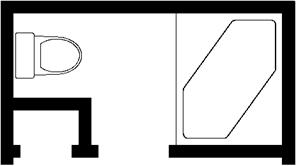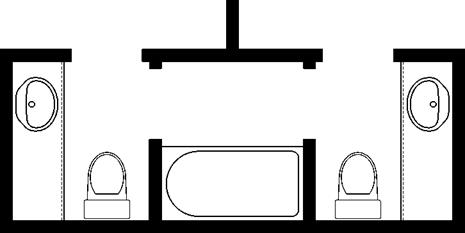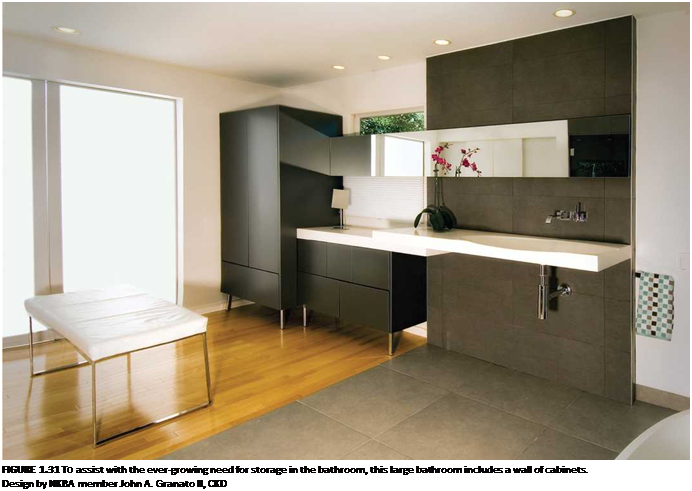• Multiple types. Once almost devoid of storage, the bathroom now contains multiple types of storage (see Figure 1.31) to handle items for the variety of activities that take place there.
• Clothes storage. In larger bathrooms, there is now more clothing storage, both folded and hanging, as part of a dressing area. These dressing areas can be entire rooms, taking all clothes storage out of the bedroom space. See chapter 9, "More Than a Bathroom," for additional information on clothes storage.
• open storage. In the form of open shelves, open cabinets, or poles with wire baskets attached, these provide visual appeal as well as convenience.
• Barn door closures. A door hanging from and sliding along a rail, much like the mechanism used on animal barns, is used as a closet door and even the door for entering the bathroom from the master suite. This type of closure allows the user to slide the door along an adjacent wall, allowing 100 percent access to the door opening.
• Appliance storage. An increase in the use of portable electric appliances/devices in the bathroom calls for more storage for these items, as well as consideration for utility connections. These appliances/devices require storage space not only in cabinets and drawers, but on the counter as well. Built-in appliances, such as refrigeration units, may need special circuits and electrical connections incorporated into the plan.

|


• Electronics. Designers are also providing storage for electronic equipment incorporated into the bathroom. A television, DVD equipment for the exercise room, a radio, a CD player, and speakers all need space out of the traffic pattern, yet positioned so they can easily be used during bathroom activities.
SUMMARY
The bathroom space, as we know it today, has evolved through time, starting with the early Greek and Roman bathing concepts, but taking its current shape during the seventeenth and eighteenth centuries in North America. Concern for sanitation and health, changes in lifestyles, the development of new materials and technologies, and the installation of a dependable infrastructure for water and waste have all fostered the design of today’s bathroom. Lifestyle changes and technological developments continue to influence the design of our bathrooms, incorporating not only function and accessibility, but also the element of relaxation fostered by the early Greek and Roman civilizations. Designers need to stay informed about demographic and lifestyle changes as well as trends in order to design bathrooms that meet the needs and desires of their clients.

REVIEW QUESTIONS
1. What role did bathing play in the life of early Roman civilizations and what elements of these baths do we have in modern bathrooms? (See "Early Civilizations and the Bath" pages 1-3)
2. Why did bathing disappear during the Middle Ages and what events prompted an increased awareness of sanitation in the eighteenth century? (See "The Middle Ages" page 3)
3. Describe how space used for bathroom activities has changed from Colonial times to the current day. (See "The American Bathroom Takes Shape" through "Design Trends" pages 5-27)
4. What is human factors research and how does this research benefit bathroom design for consumers? (See "Bathroom-Related Research" pages 10-12)
5. What are some current demographic trends related to household size, diversity, and composition in the United States and Canada? How do they impact bathroom design considerations? (See "Current Demographic and Population Trends" pages 24-27)
6. What are the general trends that have impacted the look and function of today’s luxury bathrooms? (See "Bathroom Trends" pages 27-41)



